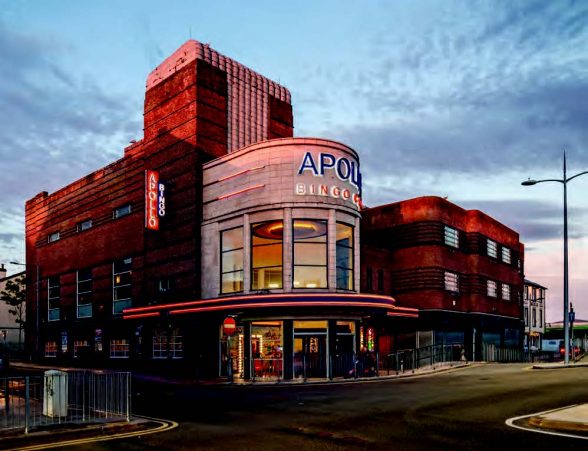This website uses cookies
This website uses cookies to enable it to function properly and to analyse how the website is used. Please click 'Close' to accept and continue using the website.


Books Round Up: Odeon Relics, Mid-Century Graphic Design and more
Reviewed by Catherine Croft

Of the 140 cinemas built before 1939, only 52 survive, of which 20 are listed. In Odeon Relics: Nineteen-thirties Icons in the Twenty-first Century, Philip Butler has photographed them all, in their current ‘weathered’ state. In some cases ‘weathered’ is a generous description, but he manages to show them as still remarkably glamorous, in many cases by shooting at night – there’s less tatty signage and buddleia than I expected. He doesn’t seek to supersede Alan Eyles’ very thorough two-volume history of the chain, but rather to ‘retrace the footprints of legendary architectural photographer John Maltby’ commissioned by Oscar Deutsch in 1935 to photograph his rapidly expanding network.
I have a few quibbles: the introduction doesn’t acknowledge that Art Deco was not a contemporary term, and apart from one Maltby shot of an auditorium, we only get to see exteriors. But it’s a handsome book and a testament to the ongoing popularity of cinema architecture. I can’t believe it’s nearly twenty years since Fabian Watkinson first led two fantastic C20 trips to some of the innovative low-rise high density social housing of the 1960s and 70s, titling his walks from some of the negative press coverage the estates received when built. Now, the ‘havens for hoodlums’ and the ‘most expensive council housing in the
world’ of that era is internationally revered. Fabian acknowledges Mark Swenerton’s Cook’s Camden as the definitive account, but his self-published paperback The Golden Age of Camden Housing is an excellent guide to all the estates, with comprehensive plans, photographs and drawings in a compact format perfect for exploring them.
The joy of Mid-Century Modern Graphic Design is its profusion of illustrations, with chapters on book covers, record sleeves, posters, magazine covers and illustrated books. Its scope is extremely wide, from the highly commercial to the world of children’s books, so it’s
best as a highly browsable visual feast, and perhaps too broad to deliver an in-depth appraisal.
Riverine: Architecture and Rivers includes several interesting essays on C20 subjects arising from a 2014 conference at the University of Kent. Gerald Adler’s own essay looks at the Memorial of the Martyrs of Deportation, in Paris, tucked away beneath Notre Dame on the edge of the Seine, and Isabelle Estiienne describes Villeneuve D’Ascq, a French New Town built around lakes in the 1970s. Elisa Alessandrini’s work on the Sabarmati river in Ahmedabad identifies how Le Corbusier’s Mill Owners Building was the first which ‘highlighted the potential of the Sabarmarti as a natural landscape, to gaze at’.
I expect that all the members who went on our President’s excellent C20 trip will already have her book Excellent Essex and be converts to a county too often dismissed as tawdry and boring (she recalls the ‘muttering about white vans, fake tans and white stilettos’). It’s an energetic and wide-ranging collection of places and ideas, pulled together with a sense of a strong personal connection to a region which has a remarkable number of undervalued 20th century sites.
Andreas Greber has done largescale site-specific work at Naters Ossuary in Valais and Federal Finance Administration in Bern, but I was particularly drawn to one of the three sets of images in Light Scripture: Analogue Reflections in Photography. For Structured Panels (199496) he photographed a panel covered in roughcast render and then projected each image back on to a panel to which a light-sensitive coating had been applied. He questions the relationship between the actual nature of a building surface and an image of one, and seems to interrogate how brutalist concrete surfaces in particular are depicted.
Emily Cole’s history of the Schooner Inns chain in this issue is a good reason to mention 20th Century Pub: from Beer House to Booze Bunker, an entertaining social and design history which came out a year or so ago. In the chapter Theme Pub: Wonderland, the authors also recall The Lion and Lamb in Greater Manchester, evoking a tropical shipwreck and featuring a live crocodile, and the ‘chrome, brass and glass extravaganza’ of the Chelsea Drugstore which opened on the Kings Road in 1968. I liked the spoof Viz advert from the ‘Flat- Roof Pub Society of England and Wales’ featuring a pub called ‘The Bloodied Fist’. But the book’s black and white photos are of only moderate quality.
We are still populating our book review section. You will be able to search by book name, author or date of publication.

Become a C20 member today and help save our modern design heritage.